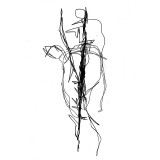We may have got used to it so that it does not impress us, but the crack is everywhere. A walk through the city will convince us: cracks in sidewalks, walls, street tar...
What is a crack? an interruption of a space-time continuum with a perspective of continuous development. The spatiotemporal continuum can express a wall or a street as it evolves through flowing time. And at some point the continuity is interrupted by the creation of a crack/-s.
The crack can stand for various things: the decay of matter over time, the entropy of a closed system, the entrance into another world dark and unknown. It can still be interpreted as non-space, as a machine that produces relief from accumulated forces, or as a gateway to the human subconscious.
Schematically, it reminds us of a lightning, a winding snake, a flowing river with tributaries... More generally, however, the crack is identified with negative characteristics or , at most, the "sublime" (on the grounds that it causes both admiration and awe).
How could such an entity/idea that is shrouded by a negative aura be an architectural element? And here lies the challenge: Architecture, this highly creative, positive, psychological and uttermost humanitarian art is called upon to reverse the facts and transform negativity into creative positivity.
And this Architecture really achieves: where a natural crack separates two sides of a surface, the architectural crack/building comes to connect different pieces of an urban (most often) space. Where the inside of a crack is dark, the architectural crack in a facade reveals the inside of a building and lets the light of the outside environment enter its interior. Where a geological crack makes the ground impassable and dangerous, the architectural walkway comes to create paths and connect landmarks.
As evidence, relevant examples/constructions are listed at the end.
